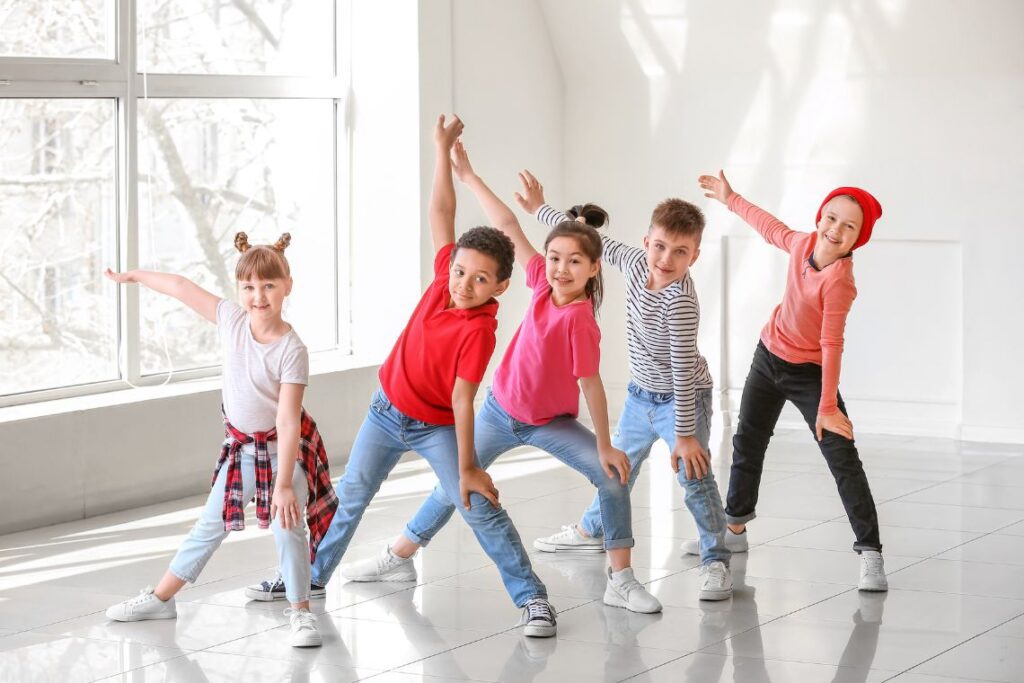Jazz dance is a dynamic and expressive art form that beautifully blends African dance, ballet, and modern dance elements. Its rhythmic nature and lively energy make it particularly appealing to children, offering them a unique opportunity to enhance their physical coordination and sense of rhythm. This blog explores how jazz dance can be a vital tool in developing these skills in young dancers and why it’s an excellent addition to any child’s activities.
The Role of Rhythm in Jazz Dance
- Understanding Musicality in Jazz Dance: Jazz dancers’ intimate connection with music, particularly jazz and blues, is fundamental to their practice. Young dancers are taught to recognise and respond to varying rhythms and beats, enhancing their sense of timing and musicality. This skill is crucial not only for dance but also for other rhythmic activities in life. By consistently engaging with the music, children learn to sync their movements to the tempo and emotion of the songs, which is essential for expressive dance performances.
- Importance of Rhythmic Exercises: Rhythmic exercises are a core component of jazz dance classes. These activities, often clapping, tapping, or stepping in time with beats, are not just fun; they’re educational. They help young dancers develop a natural sense of timing and rhythmic flow, essential for all dance styles. By practicing these exercises, children improve their ability to process auditory signals and coordinate their movements accurately with the music, fostering both dance skills and auditory processing abilities.
Enhancing Coordination Through Dance Techniques
- Mastery of Complex Movements: Jazz dance incorporates various movements, including kicks, turns, leaps, and intricate footwork. Mastering these techniques necessitates a significant level of coordination and body awareness. As children repetitively practice these movements, they sharpen their motor skills and enhance their overall physical agility and spatial awareness. This training is crucial for developing precision in dance and other physical activities, promoting a deeper connection between mind and body.
- Developing Coordination with Sequences and Combinations: Jazz dance routines often involve elaborate sequences and combinations that challenge a dancer’s memory and ability to perform movements fluidly. This dance aspect enhances coordination by compels dancers to synchronise various body parts in complex patterns. Practicing these combinations helps young dancers improve their ability to execute coordinated movements seamlessly, making it an excellent form of cognitive and physical exercise. This practice boosts their dance proficiency and enhances their general coordination in daily activities.
Practical Examples of Jazz Dance Moves
- Jazz Square: The Jazz Square is a classic jazz dance step that teaches dancers to move in a square pattern on the floor. This movement involves stepping forward, crossing over, stepping back, and completing the square, which requires coordinated arm and leg movements. It enhances spatial awareness and rhythm. It’s an excellent exercise for developing a sense of timing and grace in dance sequences.
- The Shimmy: The Shimmy is an energetic movement that involves rapid back-and-forth shoulder shakes. This movement adds excitement to dance routines and improves upper-body coordination and muscle control. As young dancers master the shimmy, they learn to integrate this fluid movement with other steps, enhancing their ability to perform complex routines that require multitasking their body parts.
- Pirouettes: Pirouettes, or spins on one foot, are foundational in ballet and jazz dance. This move requires a dancer to maintain balance and control while rotating, which demands focus and precision. Mastering pirouettes enhances a dancer’s core strength and stability, contributing significantly to their dance technique. Regular practice of pirouettes also instills discipline and boosts confidence, as these turns are among dance performances’ more visually impressive elements.
Building Confidence Through Performance
- Solo Performances: Encouraging children to perform solo routines is a powerful way to boost their confidence and individuality. Solo performances in jazz dance allow young dancers to highlight their unique skills and personal expression, pushing their boundaries and fostering a sense of achievement. These opportunities showcase their technical skills and ability to connect with an audience, making each performance a moment of personal growth and artistic expression.
- Group Choreography: Group performances in jazz dance are excellent for teaching young dancers about synchronisation and cooperation. Participating in group choreography helps children learn how to match their movements with others, enhancing their sense of rhythm and timing in a collective setting. This teamwork improves their dance abilities and builds social skills and the ability to work harmoniously in groups, fostering a community spirit and collective creativity within the dance studio.
Interactive Learning and Creative Expression
- Improvisation in Jazz Dance: Jazz dance stands out for its emphasis on improvisation, offering young dancers a unique opportunity to express themselves freely through spontaneous movement. This form of creative expression is vital as it nurtures decision-making and problem-solving skills while allowing dancers to explore and develop their distinctive styles. Encouraging improvisation in class can boost confidence as children learn to trust their instincts and respond intuitively to music, enriching their dance experience and artistic expression.
- Storytelling Through Dance: Jazz dance is not just about movement; it’s a medium for storytelling. Children learn to convey stories and emotions through their performances, which deepens their understanding of narrative structure and emotional expression. This approach to dance helps young dancers connect more profoundly with the music and choreography, teaching them to use their bodies to express complex emotions and stories. It also enhances their ability to interpret music and choreography in a way that’s personally meaningful and engaging for an audience.
Conclusion
Engaging in jazz dance provides children with a fun and exciting way to develop critical physical skills like coordination and rhythm, which apply to many other areas of their lives. Moreover, the confidence and ability to express oneself through jazz dance are invaluable.
At Kew School of Dance, we cherish the opportunity to guide young dancers through this rhythmic journey. Our classes are designed to nurture young talent, focusing on creativity, expression, and personal growth. For more information or to enrol your child in one of our jazz dance classes, please contact us at 03 9123 8458 / 0410 311 00. Let’s dance together into a world of rhythm and fun!








